Hasegawa 1/48 F4U-7 Corsair
The United States had the chance in 1945 to avoid 55 years of history, the deaths of over 58,000 Americans, several million Vietnamese and other Southeast Asians, and the self-confidence of America as a country. All that had to be done was to tell the French they could not return to Indochina, and recognize the government of Ho Chi Minh - the only Asian independence movement that had fought on the Allied side during the Second World War. The result would have been the situation that exists today, without all the bad blood both domestically and internationally. Unfortunately, following the death of Franklin Roosevelt who was committed to keeping both the French and the British out of their former colonial empires and working to see these nations receive their independence as democratic states with the assistance of the United States, the Truman Administration determined that the French - who had been defeated during the war in 1940 - might not be able to take the "shame" of being pushed out of their empire, with the result that Metropolitan France might go Communist. History has demonstrated that would not have happened, but such was the decision that was made. From 1945-50, the United States allowed France to attempt to retake their former colony, albeit without any major American aid.
The French returned to Indochina with a motley collection of cast-off aircraft acquired during the war. Douglas SBD-5 Dauntlesses, Bell P-63C Kingcobras, Spitfire IXs, Mosquitos and even Japanese Hyabusa fighters were pressed into service at the outset. By 1950, most of these aircraft had demonstrated their lack of capacity to fight the guerilla war, and both the French Navy and Air Force in Vietnam were equipped with cast-off US Navy F6F-5 Hellcats, most of which had over 2,000 hours at delivery. The SBD-5s had been replaced by two squadrons of Curtiss SB2C-5 Helldivers, which were the most modern aircraft.
Events in Asia changed in the fall of 1950, with the entry of Communist China into the Korean War, and the subsequent defeat and disorderly retreat of the American-led UN Army in North Korea. American leaders convinced themselves that this move by China signalled what might be the opening move of World War III. The anti-colonial struggle in Indochina was now seen as being part and parcel of the "international Communist conspiracy" which had begun the war in Korea.
For the French, the first benefit of this change in U.S. policy was the provision of former U.S. Navy Bearcats to the French Air Force. While the Bearcat had the excess power to maneuver effectively in restricted jungle valleys at low level, the airplane had not been designed for close air support, and the load it could carry was limited. The Aéronavale wanted something better, and the Military Assistance Program was willing to provide it for them.
The last F4U-5N came off the Dallas production line in October, 1951. It was followed by the F4U-6, which was redesignated the AU-1, since it was strictly a ground attack aircraft. Heavily armored, and equipped with ten underwing racks that could carry either 5" HVARs or 250-lb bombs each, the AU-1 had an R-2800-83W engine with only the crankcase blower as a two-speed, single-stage supercharger for low altitude work. 110 of these were in production when the Aéronavale let it be known that what they wanted for ground support in Indochina was a Corsair. Specifically, they wanted a Corsair with the ground attack capability of the AU-1 and the performance of the F4U-4.
The result was the F4U-7, which was the first brand-new straight-out-of-the-factory airplane to be delivered to the French Navy since 1940. It was essentially an AU-1 airframe with the high-altitude R-2800-18W engine of the F4U-4 (literally, since the engine was no longer in production, those used for the F4U-7 were taken off F4U-4s). The 96 that were built between June 1952 and Christmas Eve 1952 - when the Corsair production line finally closed down - would serve the Aeronavale in three different conflicts between 1952 and 1964.
The French began taking delivery of their new Corsair at NAS Oceana in October 1952. It would initially equip 14 Flotille and 15 Flotille, achieving initial operational capability in early 1954.
The first French combat use of Corsairs was in the spring of 1954, in the doomed effort to save Dien Bien Phu. 14 Flotille, at the time stationed in Karouba, Tunisia, was moved sans aircraft to Da Nang, where the carrier U.S.S. "Saipan" delivered 25 Korean-veteran AU-1s direct from Marine Air Group 12 in Japan. The Corsairs flew valiantly, along with SB2C-5 Helldivers of 3rd Flotille, losing six aircraft and two pilots; Dien Bien Phu surrendered on May 7, 1954. It was effectively the end of the French phase of the Indochina War. Following the cease-fire on July 21, 1954, the AU-1s were returned to the U.S. (They would be refurbished and sold to the French for service in Algeria a few years later.)
14 Flotille's F4U-7s were ferried out to Da Nang aboard the light carrier "Bois de Belleau," and the unit flew them for the rest of the year during the French disengagement from Indochina, returning to Algeria in the spring of 1955. By this time, 12, 15, and 17 Flotilles were engaged in the Algerian War of Independence, flying from Oran, Telergma, Bizerte, and off the British-built carrier "Arromanches" during 1955-56. Losses were light during this period.
"Operation Musketeer":
The most visible use of the F4U-7 was in "Operation Musketeer," the Anglo-French operation to secure control of the Suez Canal from Egypt following its nationalization by Gamal Abdel Nasser in 1955. In concert with Israel, the operation began in October 1956, and has been known as the Sinai War to those who were not in on what was really going on. When the Israelis had defeated the Egyptian armed forces in the Sinai and were approaching the canal in late October, Britain and France - as previously planned - called on both parties to halt operations to save the Suez Canal. Predictably, Nasser refused; the British and French intervened on November 1, 1956, with a force that included three British and two French carriers, the "Arromanches" and "Lafayette" (formerly the U.S.S. "Langley"). Flotilles 14 and 15 flew their 36 F4U-7s from these ships. Following strikes on Egyptian air bases that neutralized the Egyptian jets on the first day of the operation, the Corsairs ranged along the Mediterranean coast for the remainder of Musketeer, seeking targets of opportunity. During this time they sank an Egyptian torpedo boat, and the Commanding Officer of 14F was killed by anti-aircraft fire over Cairo, while another F4U-7 was wrecked in an operational accident. Considering that the pilots were flying up to four sorties daily, the losses were exceptionally low.
The Suez Intervention was the Corsair's last major combat operation. The 36 Corsairs had constituted one quarter of the allied forces' carrier strike aircraft. The airplanes would continue in combat use for strikes against Algerian guerrillas until the end of the War of Independence in 1961, at which time they were withdrawn to the French base of Toulon. The F4U-7s were replaced in 1964 by the F8E(FN) Crusader.
Outside of a "ridge" in the forward fuselage where the slide mold didn't fit perfectly, the Hasegawa F4U-5, AU-1 and F4U-7 all assemble very similarly to the Tamiya Corsair kit. I used Adeco Decals to do this F4U-7.
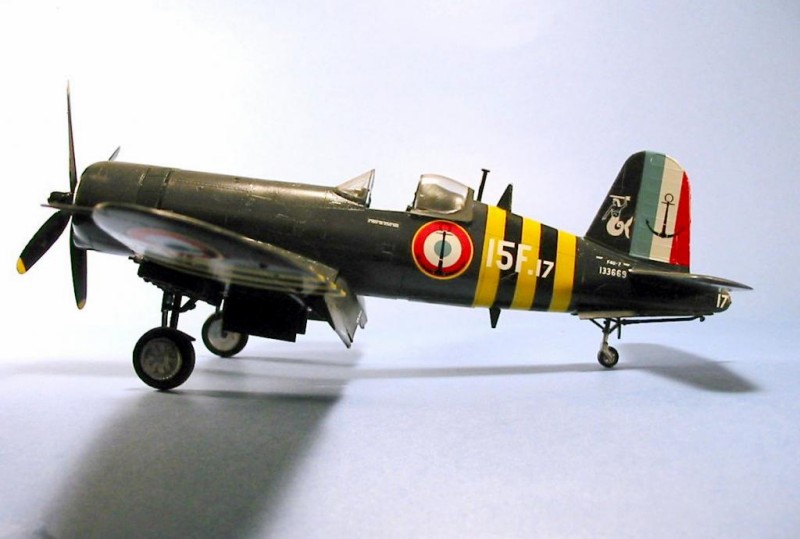
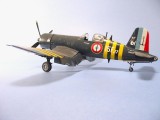
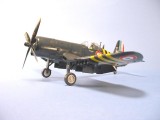
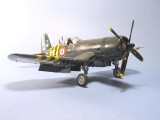
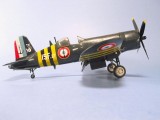

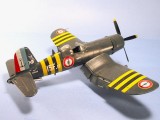
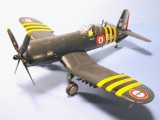
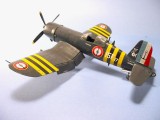
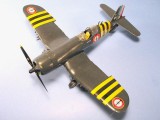

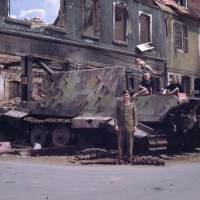

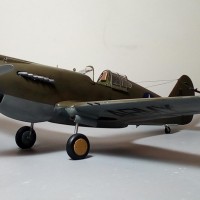
Lovely Corsair Tom. Love those French Navy markings.
Another great model from you, Tom.
Hello Tom...very nicely done F4U-7 and I agree that Hasegawa Corsair kit is fine indeed. Thanks also for the informative write-up on the F4U-7. You did a grand job on your Corsair.
Colorful Corsair Tom along with the usual informative background.
Nice looking Corsair. Like those Musketeer invasion stripes. Only one other aircraft from Op Musketeer that looked as menacing as the Corsair and that is the Westland Wyvern.
Nice job...and clear pics, too.
Yummy. Great work.
I have the adeco decals too- best I have seen for French markings.
This makes me want to pull my French AU-1 and -7 in my "soon build pile"!
Great historical background as usual with your presentations.
Why Oh Why didn't Hasegawa scale theses late Corsairs up to 1/32?
Dan.
Tom,
Your usual well done work
A great Corsair, Tom. Love the French markings, they really suit it. As usual, your background article is most informative. In some respects it is sad to see such an illustrious aircraft see out its days in this manner; but not the fault of the aircraft or the model either. Looks fantastic!